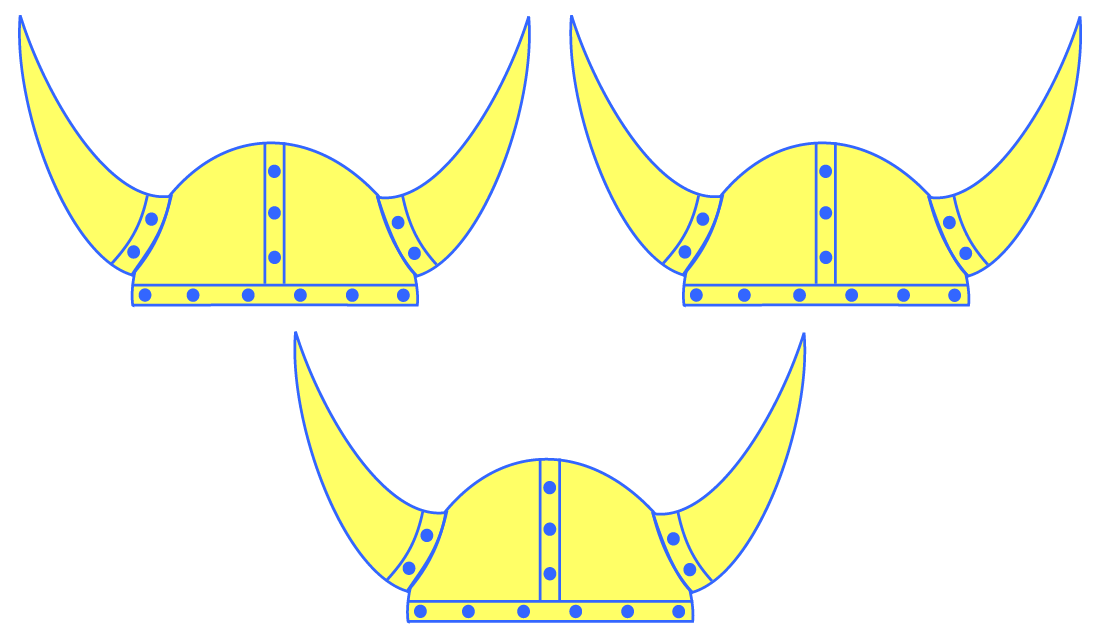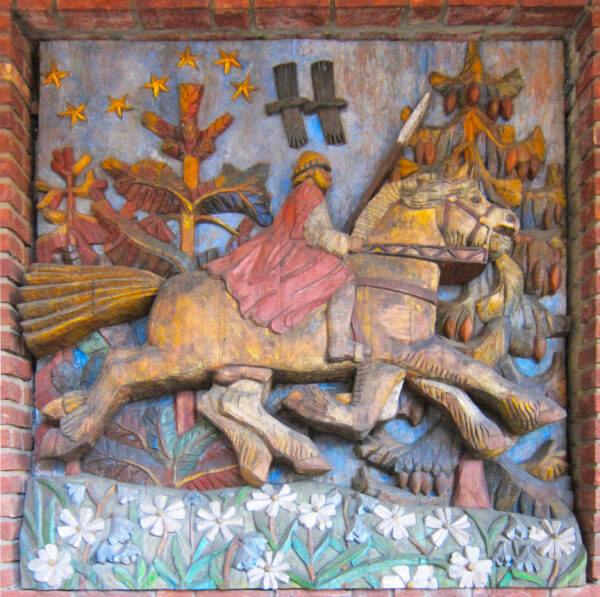
It turns out I achieved one of my very few life goals this summer by getting my sorry self published in the one and only Viking Magazine, which is unfamiliar to most people, but nonetheless exists—primarily as a benefit to members of the Sons of Norway fraternal organization here in Vinland. It’s a truly fun publication for Scandi-nerds but, naturally, not one you’ll find at the newsstands (in the rare places where those even exist anymore, anyway).
It was all a bit of a haphazard trajectory that led to my rare non-failure with Viking Magazine. My article in the September issue is all about the art adorning Oslo’s Rådhus (City Hall) in a general sense, as well as the building’s architecture and the influential precedents that had been set in Copenhagen and Stockholm. I had initially proposed an article that focused solely on the wooden reliefs that decorate the building’s exterior entry courtyard. These reliefs exclusively depict various scenes of Norse mythology (hence my intense, nerdy interest), but this focus was deemed to be too narrow and thus the article’s premise was expanded. However, I had visited the building in the grim winter of ’20 just before the world screeched to a grinding halt, and probably called undue attention to myself as I took my sweet time photographing each and every relief in the whole damn courtyard. And so, to coincide with the imminent release of the pertinent Viking Magazine issue as a sort of online companion piece, I decided to post those photos here, since the reliefs are very cool, and there aren’t many, if any, sources online that portray all of them—at least not that I’ve encountered in an easy-to-find, comprehensive way in English.
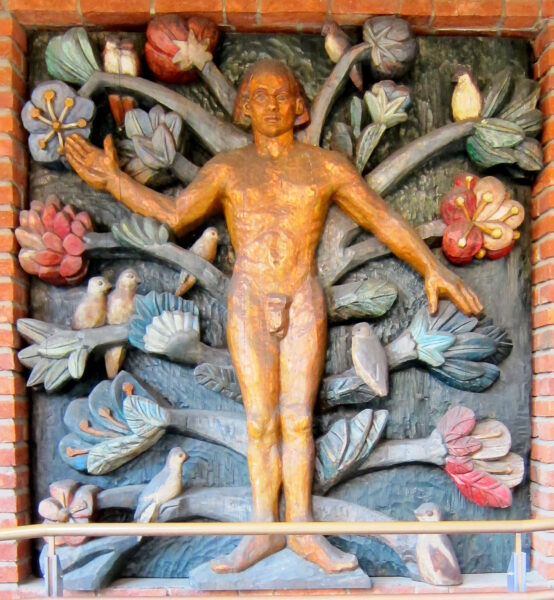
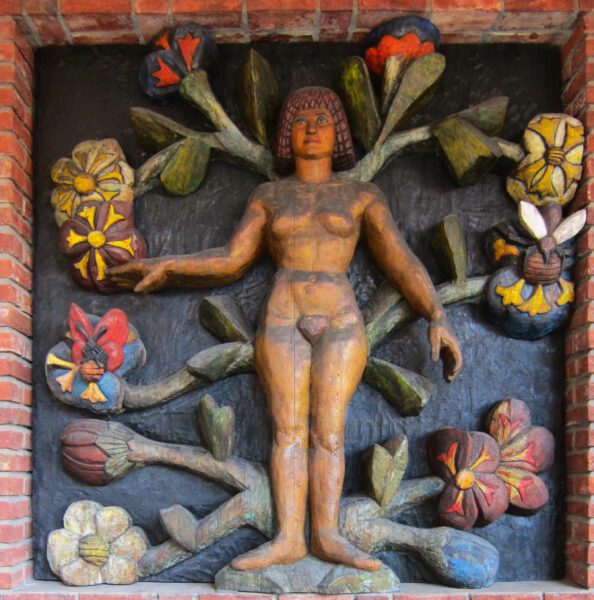
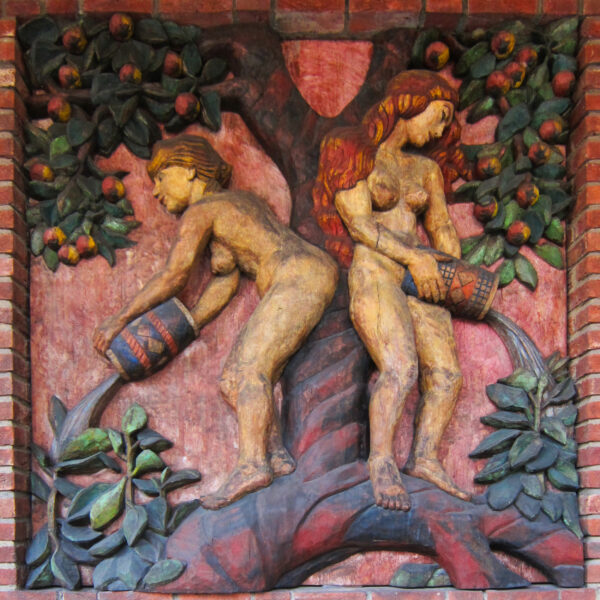
The sixteen reliefs themselves are collectively known as Yggdrasilfrisen (“The Yggdrasil Friezes”) and are the creation of Dagfin Werenskiold, son of Erik Werenskiold, who was one of Norway’s most prominent painters in the late 19th century and who, alongside Theodor Kittelsen, helped establish the popular image of trolls as we now know them today thanks to his many illustrations for Asbjørnsen and Moe’s collection of Norwegian folktales. Dagfin Werenskiold created these reliefs in the 1940s during the final phases of the planning and building of Oslo’s rådhus (a major national competition was held to select the artworks that would appear outside and inside the building; construction on the building itself had begun in the early 1930s, however).
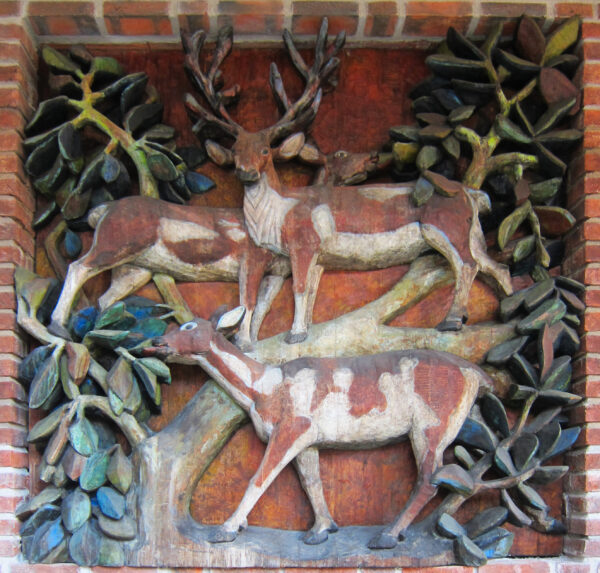
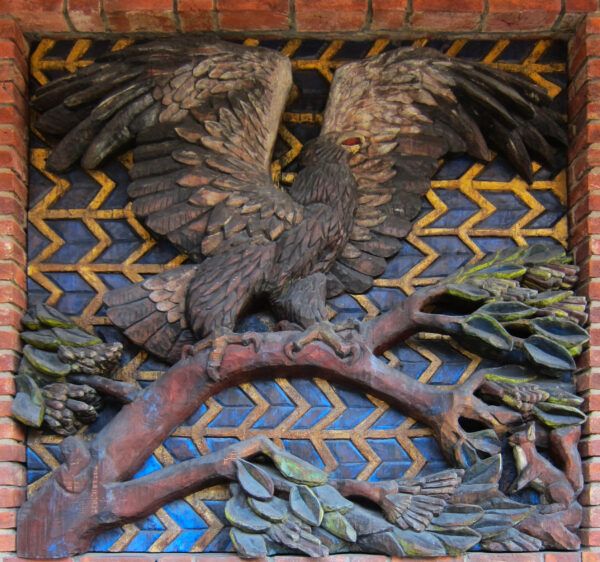
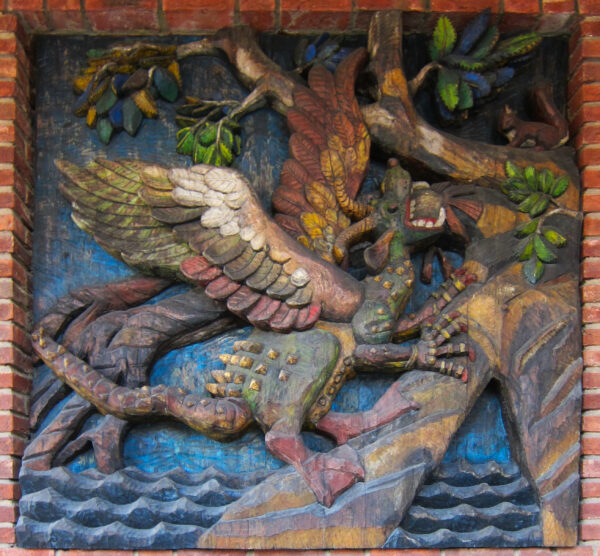
Each of the sixteen reliefs is made of pine wood, measures 2.3 meters x 2.2 meters, weighs 1000 kg, and is ornately painted. They flank the two opposing facades of the courtyard, eight reliefs apiece. They’re presented here in roughly chronological order per the cycle of the Norse myths themselves with a little interlude for the harrowing tale of Volund the Smith (as opposed to the order in which they are actually found at the rådhus, which would be difficult to convey without creating some sort of map or table or getting bogged down in explanatory language, plus I personally like this more orderly order).
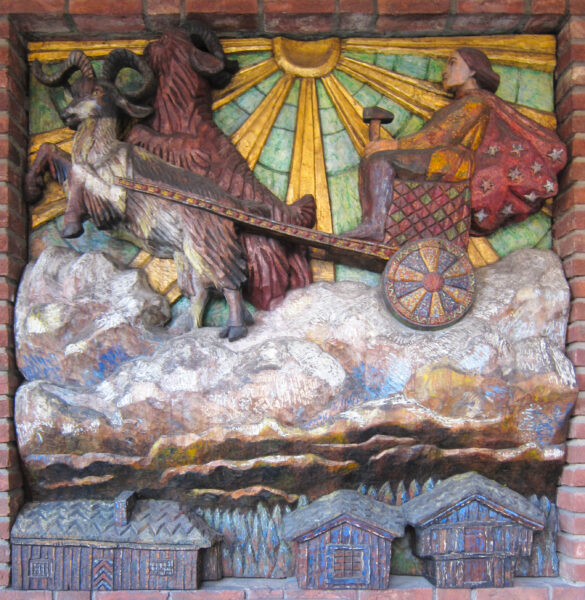
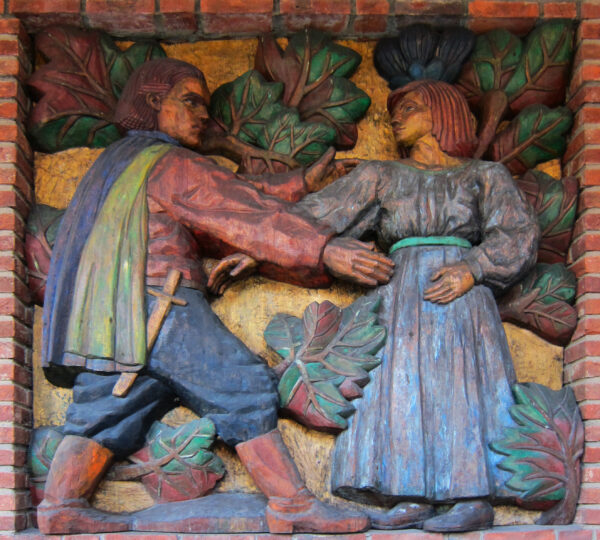
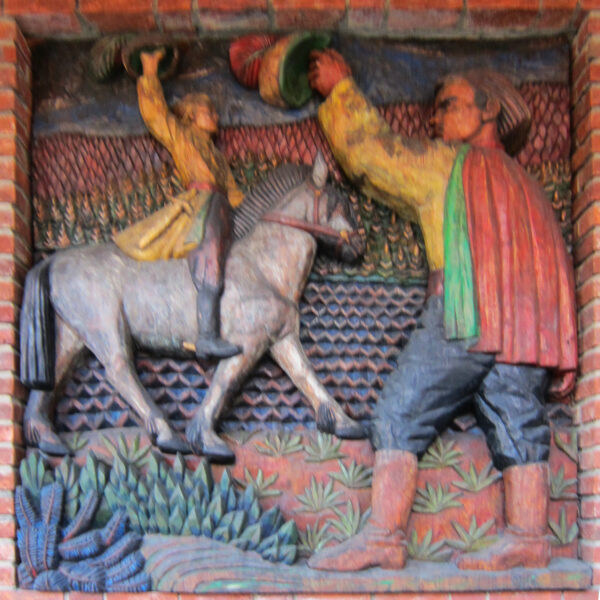
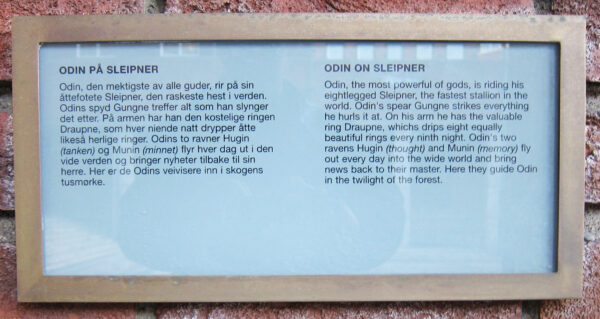
The rådhus’ facade also provides an overall placard that relays some of the general background information regarding Werenskiold’s work as well as a smaller placard for each relief that describes the scene it depicts. Each of these looks like the one I’ve included here, which pertains to the relief of Odin riding his horse Sleipnir (shown at the top of this page).
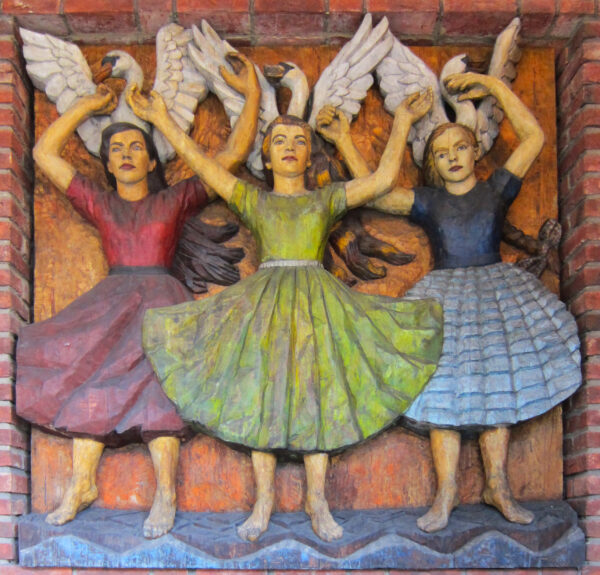
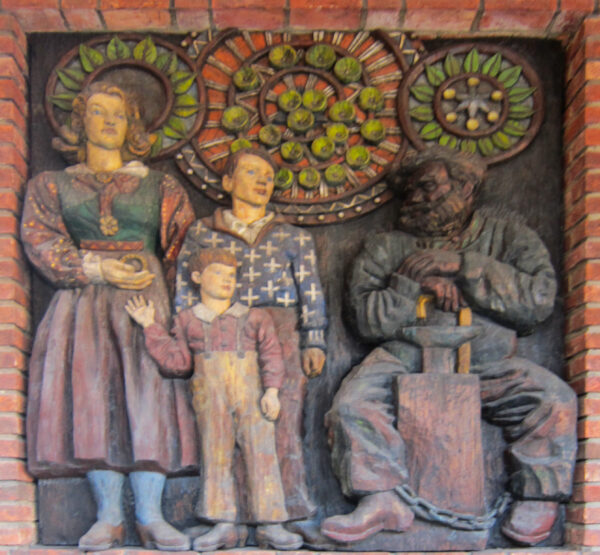
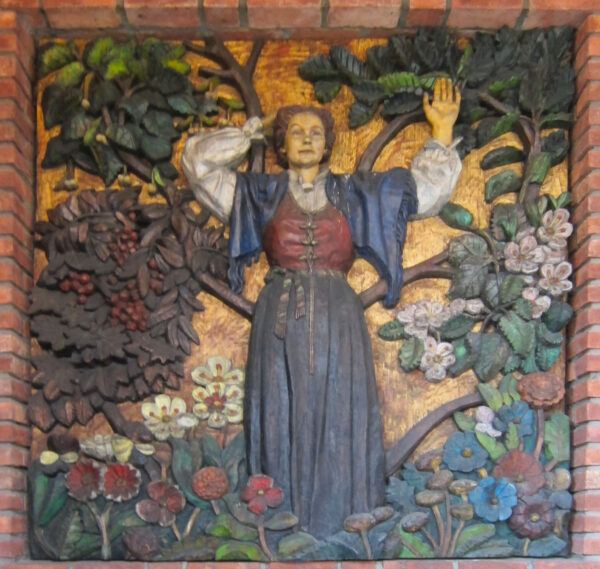
For those of you who want to go really deep into these reliefs, each of the English language versions of the placard descriptions is provided at the bottom of this page. They appear in the same order as the images of the reliefs on this page themselves. And if you want to learn more about the rest of the art and architecture of Oslo’s Rådhus, then I encourage you to pick up a copy of the September 2021 issue of Viking Magazine! Lastly, some great images of the artwork found throughout the building (including more information about the reliefs) may be found at Oslo’s official Kunstsamling (“art collection”) webpage, but note—it’s only in Norwegian: Oslo kommunes kunstsamling.
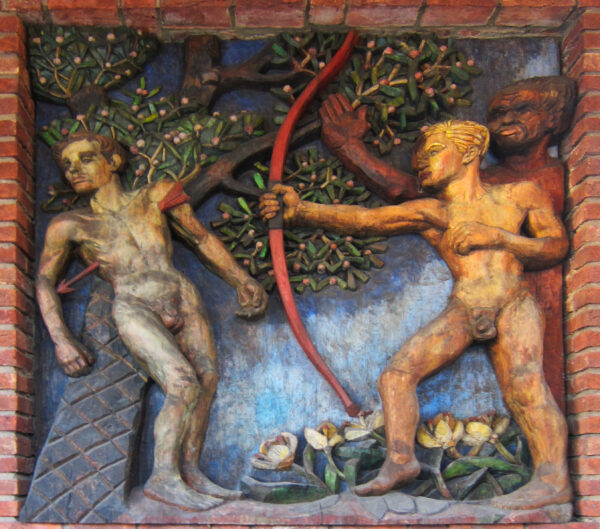
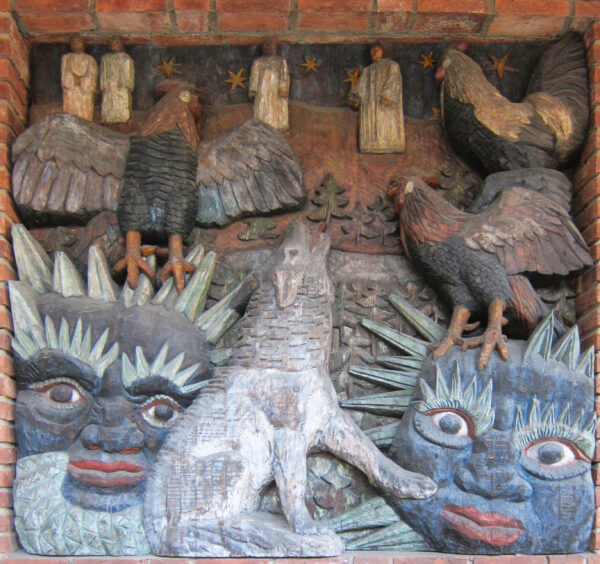
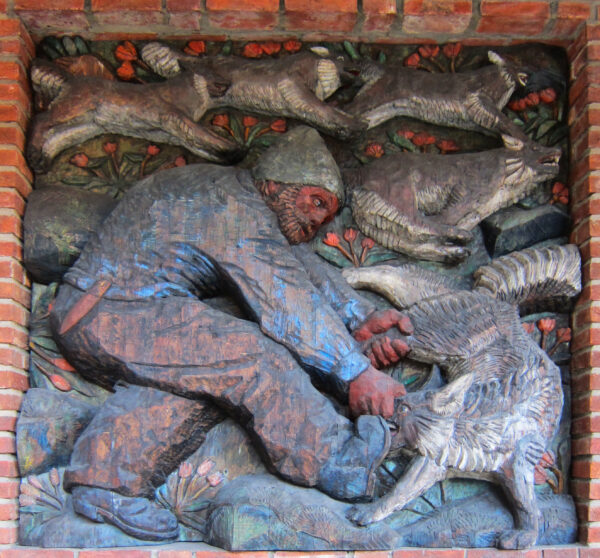
CAPTIONS TO THE RELIEFS
ODIN ON SLEIPNIR: Odin, the most powerful of gods, is riding his eightlegged Sleipnir, the fastest stallion in the world. Odin’s spear Gungne strikes everything he hurls it at. On his arm he has the valuable ring Draupne, which drips eight equally beautiful rings every ninth night. Odin’s two ravens Hugin (thought) and Munin (memory) fly out every day into the wide world and bring news back to their master. Here they guide Odin in the twilight of the forest.
ASK & EMBLA (these two reliefs share the same description): The gods Odin, Høne and Lodur are out wandering. At the beach they find two trees “without destiny.” Fate is granted by the gods who empower them: Odin gives them spirit, Høne gives them the gift of vitality and Lodur gives them blood and colour. Ask (ash) and Embla (elm) step forward through the myth of creation as the two first human beings.
THE NORNS POUR WATER ON YGGDRASIL: The norns Urd (the past), Verdande (the present), and Skuld (the future) are three powerful goddesses of destiny. The live by the Well of Urd where one of the roots of Yggdrasil ends. Here the gods ride over Bifrost (the bridge that connects heaven and earth, the rainbow bridge) on their way to council. The norns water the world tree’s leaves each day with spray water from the flood. From this comes the dew that falls in the valleys, and this is why the hold tree remains evergreen above the Well of Urd.
DEER GRAZING ON YGGDRASIL: Four deer are grazing on the world tree Yggdrasil’s green shoots: Dåin, Dvalin, Dunøy and Duratro. Three of them are here portrayed as symbols of “peace, cautiousness and timidity.”
THE EAGLE IN YGGDRASIL: High up in Yggdrasil’s branches a powerful eagle is sitting looking far around him and flapping his large wings. The small squirrel Ratatosk is running down the trunk carrying the eagle’s words to the beast Nidhogg (the one who cuts with malice or evil), who is gnawing at the world tree’s root.
NIDHOGG: Nidhogg (the one who cuts with malice or evil) is a dragon-like, serpent beast who gnaws and tears at the third root of the ash Yggdrasil, the world tree. Yggdrasil has roots that spread in three directions: one leads to the giant Mime’s (memory’s) well, the source of recollection. Here everything that has ever happened is reflected, and Mime’s well is therefore full of wisdom. There rests Odin’s eye pawned so that he may drink of the fountain of Mime. Another root leads to the Well of Urd, whilst the third goes down to Kvergjelmir in Nivlheim (the underworld, kingdom of the dead), where Nidhogg commits his fearful deed.
TOR IS DRIVEN BY HIS GOATS: After Odin, Tor is the next most distinguished god. He is the god of strength and often battles with the giants. The chariot he drives is drawn by the two goats Tanngnjost and Tanngrisne. Tor owns three valuable things: the hammer Mjollne that always strikes when thrown and returns of its own volition, a pair of magnificent iron gloves, and a belt which increases his strength.
The little farm rests under threatening skies. When Tor travels in his chariot across the sky and strikes his hammer, thunder crashes and lightning blazes. And when the storm clears, Tor’s beautiful hall Bilskirne (fair weather) is revealed.
FRØY AND GERD MEET
Frøy is a popular god who rules over the fruits of the earth and protects domestic animals. One day he sits on Lidskjalv, Odin’s throne in Valhall. From there he contemplates the view of the world and sees the female giant Gerd (of the earth) in Jotunheimen. Frøy is so moved by his love of her that he can neither eat, drink nor sleep. He uses his servant Skirne to woo Gerd, and finally meets her in the Barre (barley) grove.
FRØY AND SKIRNE: Frøy confides his powerful love of Gerd to his household servant Skirne, and asks him to travel to Jotunheimen to woo her on his behalf. Skirne does so on one condition; that he may take Frøy’s magical sword – the one that can strike of its own volition – with him on the dangerous journey. Gerd refuses all fair promises of gifts, but when Skirne employs conjurations and threatens to carve out magical runes, Gerd is forced to submit and meet Frøy “in nine night’s time in the Barre grove.”
THE SWAN MAIDENS: The valkyries (those who choose the warriors destined to die in battle), half spiritual, half earthly, come flying as swans and change into three beautiful maidens Alrund, Svankit and Alvit. Three brothers discover them at the beach, carry them off and marry them. The smith Volund marries Alvit.
After seven years the swan maidens depart again. Volund remains at home awaiting his wife’s return, whilst his brothers leave to search for theirs.
VOLUND THE SMITH HAS VENGEFUL THOUGHTS: The evil and greedy King Nidud (evil) captures Volund, severs his hamstrings and orders him to forge costly jewellery on a deserted island. The King has stolen a ring from Volund and given it to his own daughter Bodvil. Now the ring is broken in two, and Bodvil secretly travels to meet Volund in order to have it forged into one whole ring again. The King’s two sons are tempted to the island by all the gold the smith has.
Volund cuts off the boys’ heads, mounts their skulls in silver and sends them to King Nidud as drinking vessels. From their teeth he makes a brooch to Bodvil, and he mounts their eyeballs as precious stones in a piece of jewellery for the Queen. Finally he rapes Bodvil and she becomes pregnant with his child.
FRIGG: Frigg (love) is one of Odin’s wives and the mother of Balder (lord, prince), the god of innocence and piety. Balder is haunted by evil dreams, and Odin rides to Nivlheim (the underworld, kingdom of the dead), where he awakens a dead mystic. Through her he gets to know that Balder is going to die, the halls of Nivlheim are adorned and await him. As a result Frigg makes all elements swear on oath that they will not hurt Balder: fire and water, iron and iron-ore, rocks, earth, trees, animals and plants – except the mistletoe, “because she felt it was too young.”
THE DEATH OF BALDER: The giants are constantly battling with the gods. Loke is of giant descent and is Odin’s foster brother. He is evil and cunning, and the one who indirectly causes the death of the god Balder. The other gods amuse themselves by shooting at Balder, safe in the belief that nothing can hurt him. Balder’s half brother, the blind and strong Hod (battle), is deluded by Loke into “showing Balder the same honour.” Loke gives Hod and arrow of mistletoe and assists him in aiming at Balder. Thus Hod becomes his brother’s killer.
WARNING OF RAGNAROK: The formidable dog Garm guards the entrance to the underworld (kingdom of the dead) and warns of the destruction of the old world – Ragnarok (supremacy’s destiny, the twilight of the gods). Three cocks crow and warn of the pending battle: the Aesir’s golden crested cock Gullinkambi who wakes Odin’s heroes, the soot-red dock down in the underworld, and the red cock Fjalar in the world of the giants. A flock of gods, giants and evil spirits are to fill the entire battlefield of Vigrid (the largest in the world) or Oskopne (the one which is not yet created). The sun will be extinguished, the wolf Fenris is to devour Odin, and Tor and Frøy will die in battle.
VIDAR CONQUERS THE WOLF FENRIS: Vidar (the silent god), son of Odin, takes revenge for the entire family of gods by conquering the wolf Fenris. On his foot he wears an amazing shoe made from the leather cobblers cut off at the toe and heel. Vidar puts his foot in the wolf’s lower jaw and takes hold of the upper jaw in his hand. The wolf is unable to bite through, and Vidar thrusts his sword into its heart.
